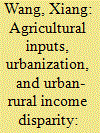|
|
|
Sort Order |
|
|
|
Items / Page
|
|
|
|
|
|
|
| Srl | Item |
| 1 |
ID:
168344


|
|
|
|
|
| Summary/Abstract |
Income inequality is undoubtedly a potential economic and social risk for any country in the world. For China, the improvement in agricultural production capacity and the steady progress of urbanization are fundamental guarantees to mitigate unbalanced urban-rural development and alleviate urban-rural conflict. However, previous studies have paid little attention to the effects of agricultural inputs such as chemical fertilizers on urban-rural income disparity. Based on a data set of 30 provincial-level regions in China over 1997–2015, we use the system generalized method of moments to investigate the impacts of agricultural production inputs and urbanization on urban-rural income disparity. The results show that increasing urbanization has a significant effect on mitigating urban-rural income disparity. The intensity of chemical fertilizer application also has a significant impact on the disparity, but the impact depends on the level of urbanization. For the provinces with relatively low levels of urbanization, an increase in the intensity of chemical fertilizer application can moderate the disparity, while a decline in the intensity of chemical fertilizer application can narrow the disparity in more urbanized provinces. The threshold levels of urbanization present a time-varying characteristic; however, the threshold effects are significant over the entire sample period. Therefore, during the process of further urbanization in China, it is necessary and urgent to appropriately adjust the pattern of chemical fertilizer application and thus reduce the over-dependence on chemical fertilizers in agricultural production.
|
|
|
|
|
|
|
|
|
|
|
|
|
|
|
|
| 2 |
ID:
116935


|
|
|
|
|
| Publication |
2012.
|
| Summary/Abstract |
Following the goal of improving on-road fuel efficiency, the Spanish Government engaged in an active policy called the dieselization between 1998 and 2006, which was intended primarily for light duty vehicle (mostly passenger cars and SUV's). However, the effect of the dieselization on controlling emissions has been questioned by many authors. At the Spanish national level, we first provide descriptive evidence of the effects of dieselization on passenger cars emissions. Second, we use a panel data set for 16 Spanish regions between 1998 and 2006, and estimate a dynamic panel data model that relates CO2 emissions generated by passenger cars with a set of variables related to the dieselization process, fuel efficiency and other control variables. Combining both analysis, we find the existence of a significant indirect, negative effect on CO2 emissions caused by the dieselization, which is more important than the direct, positive technology-efficiency impact.
|
|
|
|
|
|
|
|
|
|
|
|
|
|
|
|
| 3 |
ID:
140232


|
|
|
|
|
| Summary/Abstract |
This paper examines how bank capital affects bank profitability and risk in China, and how its impact differed before and after the nation entered the WTO. Our study uses the dynamic generalized method of moments approach with a panel database containing 171 Chinese commercial banks. We find that bank capital has significant influence on bank profitability and risk, but its impact has declined since China joined the WTO in 2001. For different sized groups, the impact of capital on profitability exhibits a distinct trend. The effects of capital on bank risk are different for large and small banks depending on the risk variables used for the Chinese banking industry.
|
|
|
|
|
|
|
|
|
|
|
|
|
|
|
|
| 4 |
ID:
096225


|
|
|
|
|
| Publication |
2010.
|
| Summary/Abstract |
Using a panel dataset for 28 sub-industries from 5 Chinese industries from 1995 to 2006, this paper examines the impact of human capital, R&D expenditure and FDI spillover on the productivity improvement of Chinese high-technology industries. The whole industry sample results suggest that human capital promotes total factor productivity, technical change and technical efficiency change, but that FDI lowers all of these factors in Chinese high-technology industry. When we distinguish between types of ownership structure in the industries, we find that human capital improves technical change but lowers technical efficiency change, whereas FDI only improves technical efficiency change in state-owned and state-controlled enterprises but reduces technical change in state-owned and state-controlled enterprises and joint ventures.
|
|
|
|
|
|
|
|
|
|
|
|
|
|
|
|
|
|
|
|
|